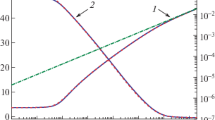Abstract
The rate of growth of a bubble is determined from the self-similar solution of the heat-transfer equation. A comparison is made with the Labuntsov-Scriven approximation.
Similar content being viewed by others
Literature cited
L. E. Scriven, “On the dynamics of phase growth,” Chem. Eng. Sci.,10, Nos. 1–2, 1–13 (1959).
D. A. Labuntsov, B. A. Kol'chugin, V. S. Golovin, É. A. Zakharov, and L. N. Vladimirova, “High-speed motion-picture study of bubble growth in the boiling of saturated water over a wide range of pressures,” Teplofiz. Vys. Temp.,2, 446–453 (1964).
D. C. Jones and N. Zuber, “Bubble growth in variable pressure fields,” Trans. ASME, Ser. C: J. Heat Transfer,100, No. 3, 453 (1978).
N. S. Gradshtein and N. M. Ryzhik, Tables of Integrals, Series, and Products, Academic Press (1966).
Author information
Authors and Affiliations
Additional information
Translated from Inzhenerno-Fizicheskii Zhurnal, Vol. 41, No. 5, pp. 869–873, November, 1981.
Rights and permissions
About this article
Cite this article
Pavlov, P.A. Growth of vapor bubbles in a highly superheated liquid. Journal of Engineering Physics 41, 1233–1236 (1981). https://doi.org/10.1007/BF00824925
Received:
Issue Date:
DOI: https://doi.org/10.1007/BF00824925




